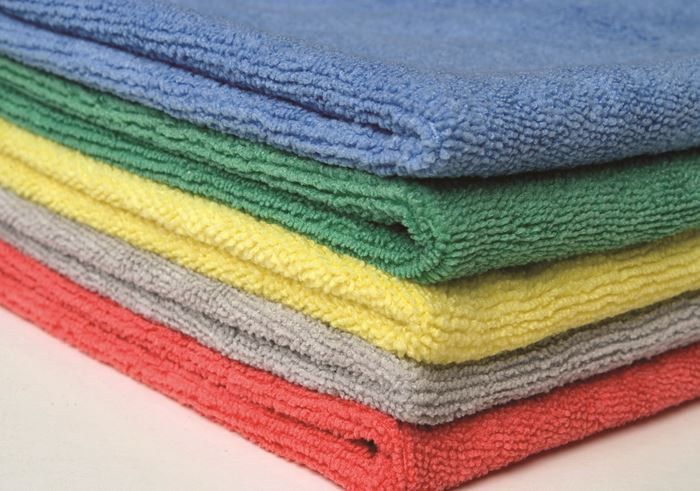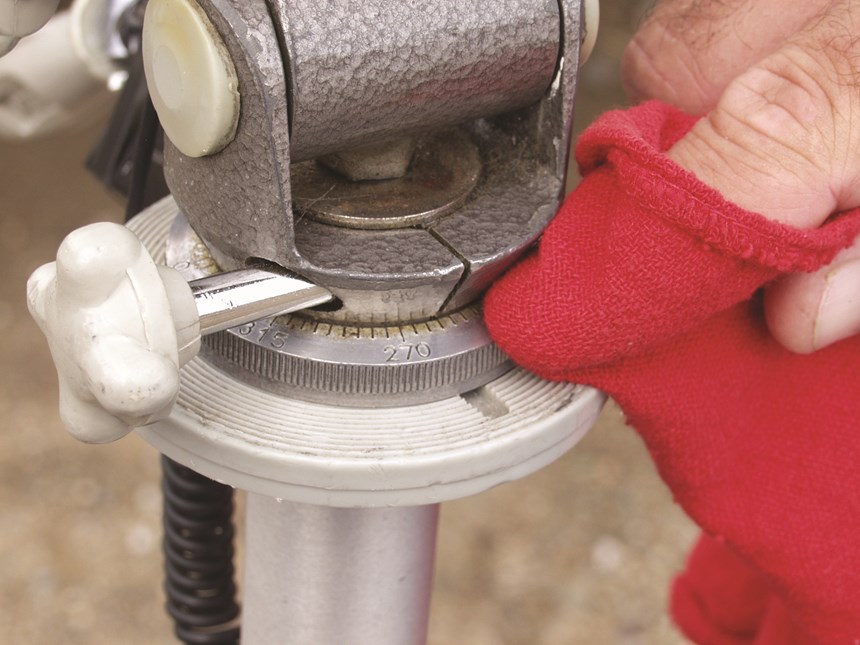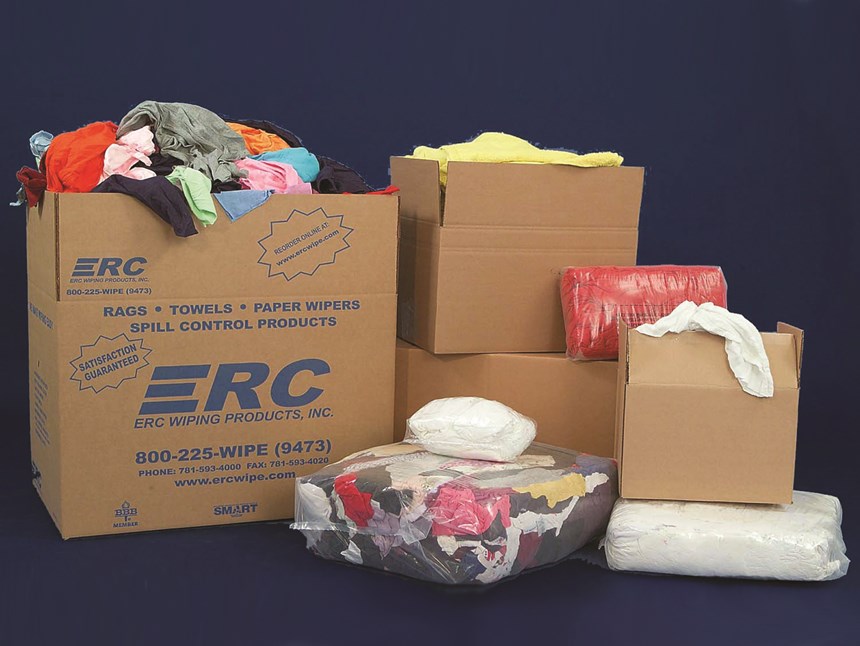Published
Wiping It Clean
In a manufacturing environment, cleanliness is always important and is often an essential part of the process.
Eric Gaudet, Marketing Director, ERC Wiping Products Inc.
Share




In a manufacturing environment, cleanliness is always important and is often an essential part of the process. There are many methods of cleaning depending on the type of manufacturing or surfaces being cleaned including aqueous cleaning, solvent cleaning, mechanical cleaning, precision cleaning and drying. The best cleaning practices often combine multiple cleaning methods as different parts of a process may require different methods to clean. In many instances, wiping cloths, rags, paper or nonwovens, microfiber cloths and clean room wipers must be used in conjunction with the other cleaning methods, resulting in a reliable streamlined cleaning process.
Wiping cloths are used in many areas of the manufacturing or surface cleaning process. They can be used for general cleaning, during the actual parts manufacturing process, upon final quality control inspection, or afterwards to clean the machinery. Many people think that a rag is just a rag, but choosing the right wiper can be critical. Some rags are perfect for general cleaning, other wipers are great for low tech manufacturing, while clean room wipes are essential for critical tasks such as in the manufacturing of some medical or computer equipment.
There are four categories of wipers available to purchase. The key is to find the right wiper to match the job. Often times, several types of wipers might be required. Various manufacturers include fabrication, electronics, medical, military, automotive, aerospace, marine, oil and production facilities. All of these industries have different wiping applications. The four types of wipers available are cloth wipers/rags, paper and non-woven wipes, microfiber cloths, and clean room wipers.
Cotton Wiping Cloths & Rags
There are hundreds of different types of rags available. Selecting the right wiper involves considering the texture, size, color, and type of cloth required. Starting with color, if solvents are in use, it is suggested to stick with white wiping cloths, since solvents might pull the dye out of the color cloths and onto the surface. White is also critical if it is important to see what has been wiped, or if the rag needs to be professional looking.
Second, the required thickness of the cloth should be determined. If you need a thick, durable cloth for either wiping a large surface or perhaps even touching a hot part, then thicker rags such as terry would be best. Perhaps the process involves wiping intricate parts and a small space needs to be wiped. In this case, a thinner wiper such as cotton t-shirt material or woven sheeting may be best.
Third, determine if lint is a factor. There are many different levels of “lint-free” in the manufacturing world from low-lint wipers to actual lint-free wipers used in a clean room environment. The degree of lint-free is relative and depends on the applications. For example, for prepping a surface to paint, a lint-free wiper should be used so that particles will not show on the finished surface. On the other hand, to clean grease from a tool or hands, a low-lint cloth or wiper will be suitable.
The following are several of the most popular wiping cloths.
Terry Towels: Toweling is one of the most common rags because it is very absorbent and durable. Terry is typically all cotton and is available in many different sizes, ranging from the size of a wash cloth up to the size of a large bath towel.
Cotton Sheeting: Woven sheets are processed from bed sheets, so they are thin and lint-free. Although they are light weight, these cloths are still absorbent despite naturally absorbing less than thicker cloths such as terry and t-shirt material. The qualities of these cloths make them ideal for wiping surfaces or products without leaving particles behind, and since they are very lightweight and thin, they are great for cleaning small parts.
Cotton Knit Jersey: Cotton knit jersey is one of the most versatile cloths and is available in either recycled or new material. Recycled jerseys consist of t-shirts, polos and jerseys, and although they are mainly cotton, some may contain a poly blend. Jersey is absorbent, low-lint, soft and feels good on the hands. It is useful for prepping surfaces and wiping metals, machines, oil and grease. New knit jersey is not as absorbent as recycled jersey, but it is made from new t-shirt material. The pieces are typically more uniform, usually rectangular, and also lower in lint. New white t-shirt material is extremely popular in many manufacturing processes because it is absorbent and low in lint.
Other recycled clothing such as sweatshirt material and color flannel are also widely used rags.
Shop Towels: Traditional red, white, and blue shop towels (non-rented) are cotton, uniform in size, and are typically supplied with many rags per case. These cloths are also on the thinner side, making it easy to wipe in tight areas
Paper and Nonwoven Wipers
Nonwovens/paper wipers are available in many options including DRC, airlaid and spunlaced. DRC wipers are cloth-like wipers made of wood pulp and binders. These wipers are gentle on the hands yet durable enough for general purpose wiping of grease, oil, paint and water. Airlaid wipers have similar qualities as DRC wipers but are created with an economical cellulose wiper bonded together using an air process in manufacturing. Spunlaced wipers are made of wood pulp and textile fibers that are bonded together using hydro manufacturing technology. Since there are no chemical binders, these wipers are solvent resistant. They are also considered lint-free, very absorbent, hold up well against sharp edges and they have a cloth-like feel and strength, even when they are wet.
Paper and non-woven wipers are very popular because there are so many options that can satisfy any application. Not only are many different materials available, but there are many different packaging options such as pop-up boxes, quarter-folded in poly bags, flat bulk, on a roll, in a dispenser, and so on. Soft nonwovens and soft wiping fabrics also make excellent packaging or wrapping materials as they help to prevent etching or scratching of clean surfaces or anodized parts.
Microfiber
Microfiber is a lint-free, non-abrasive, synthetic material that has been around for nearly a decade and has become a very popular wiping and polishing cloth. Microfiber cloths actually have millions of microscopic hooks that attract, absorb and remove particles from most surfaces including high gloss products, metal, plastic, glass, ceramic, stone and more. Microfiber is also ideal for rewashing as they are designed to be laundered hundreds of times. It is the trusted wiper for many industries, and one of the most durable cloths on the market. Microfiber is available in a variety of sizes and colors.
Clean Room Wipers
There is a wide array of clean room wipers available. The choice of wiper depends on the class of clean room that it is being used in, such as laser print cartridge manufacturing versus medical syringe manufacturing. Both need a clean room product, yet the medical device has a higher clean room standard. Clean room wipers can be made of paper, polyester or cotton. Spunlace wipers are a popular class 100 wiper. These wipers are lint-free and satisfy many clean room specifications.
Another Option
The other option for wiping cloths is to rent, but for process cleaning, using wiping cloths from laundry services can be risky. The issue with rental cloths is that they have been known to have solvent residue, foreign objects and metal shavings left over from a previous use, and this is a serious concern. In some industries this may not be as much of an issue but when it comes to manufacturing, it is not good for unknown solvents to mix or for parts or products to be scratched when they are wiped. Shop rags are often rented, but they cost nearly the same whether rented or new. Shop rags may appear to cost more from a distributor, but when all the rental fees including lost charges, minimum charges and environmental charges are added, the price can be more than purchased towels. The best bet is to find a distributor that can provide new shop towels to avoid unexpected expenses.
Environmental Impact
Many cleaning processes are already green, such as aqueous cleaning methods, and many are in the process of becoming green, such as safe solvent cleaning systems. For those with a green focus, there are several wiping products that provide eco-friendly cleaning including recycled cloths, microfiber cloths and paper wipers made from recycled materials.
Recycled cloths are converted from used clothing and commercial laundries. Many nonwovens are often made from off spec materials. By converting these materials into wiping cloths, the life of the textiles has been extended.
Microfiber cloths are a popular “green” option because they effectively clean without the use of chemicals, which is often important in a manufacturing environment. They can also be used for a longer period of time – in the area of hundreds of washings – when compared to other cleaning cloths. Microfibers also help operations get LEED certified and will help increase LEED ratings for building cleaning and maintenance.
One of the newest innovations combines the cleaning qualities of lint-free microfiber with the qualities of nonwovens to create a low-cost, durable disposable wiper. “Green” DRC paper wipers are a newer product that can be used in place of other paper wipers without compromising quality. These wipers are actually made from a combination of post-consumer recycled fibers and post-industrial recycled fibers, and they meet the EPA comprehensive procurement guidelines. As with other DRC wipers, these are very durable, low-lint, cloth-like and absorb water, oil and grease without falling apart.
Keeping the manufacturing environment clean is an important part of the overall process. Many wiping options are available to integrate with other cleaning processes and to fit specific applications based on material, texture, size, price and environmental impact. Manufacturers should look for wiper suppliers that are willing to work with together to help figure out the right wiper for each application. PC
Read Next
Automation
Setting Up the Building Blocks for a Digital Factory
Woodward Inc. spent over a year developing an API to connect machines to its digital factory. Caron Engineering’s MiConnect has cut most of this process while also granting the shop greater access to machine information.
Read More5 Rules of Thumb for Buying CNC Machine Tools
Use these tips to carefully plan your machine tool purchases and to avoid regretting your decision later.
Read MoreRegistration Now Open for the Precision Machining Technology Show (PMTS) 2025
The precision machining industry’s premier event returns to Cleveland, OH, April 1-3.
Read More



























.jpg;maxWidth=300;quality=90)







